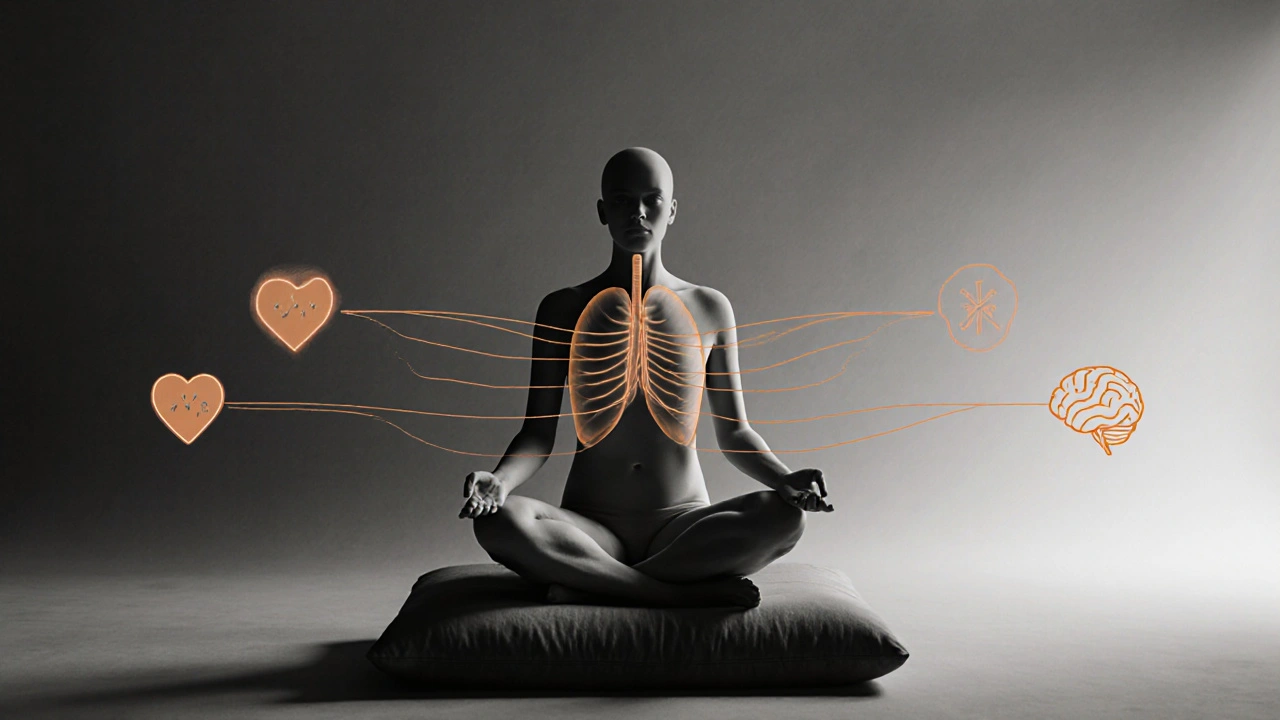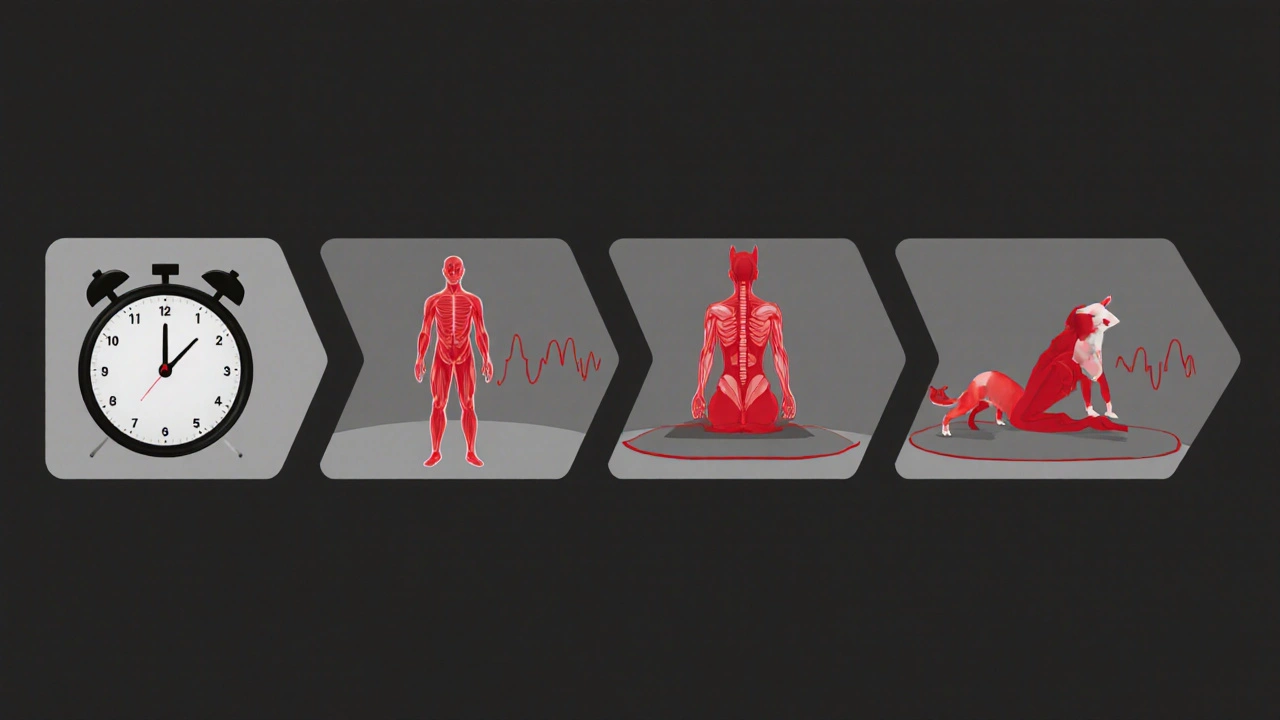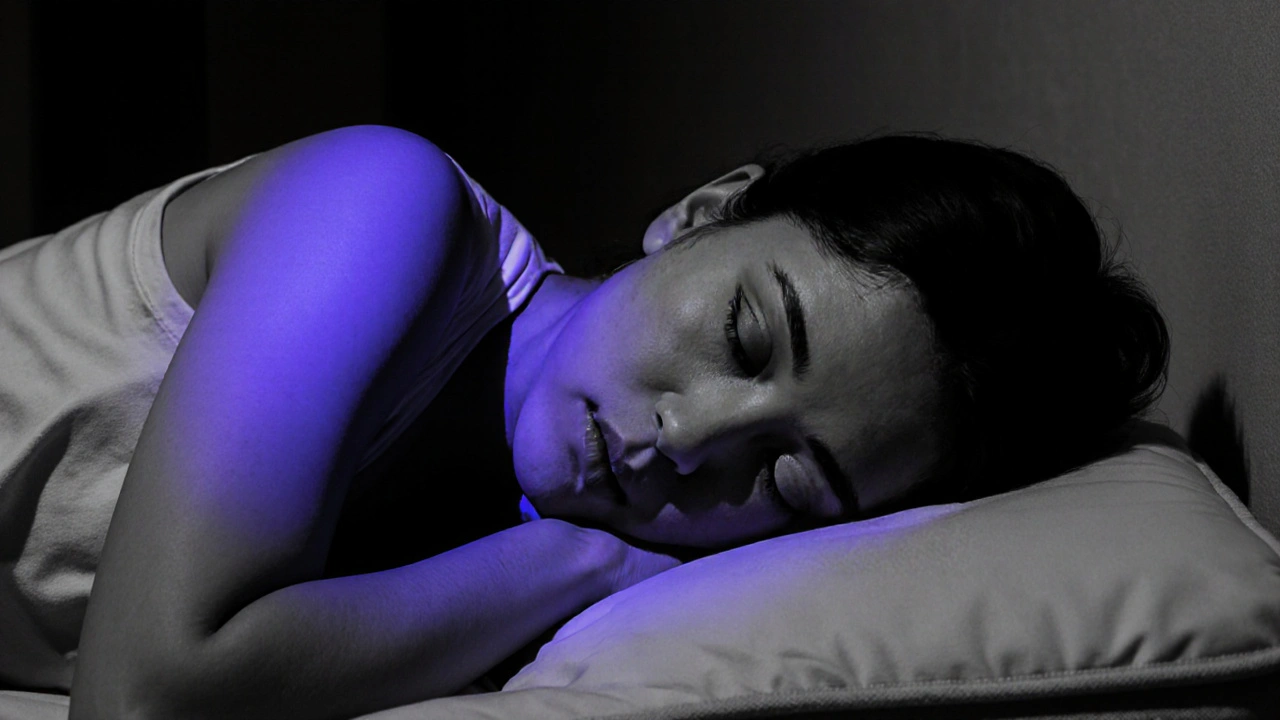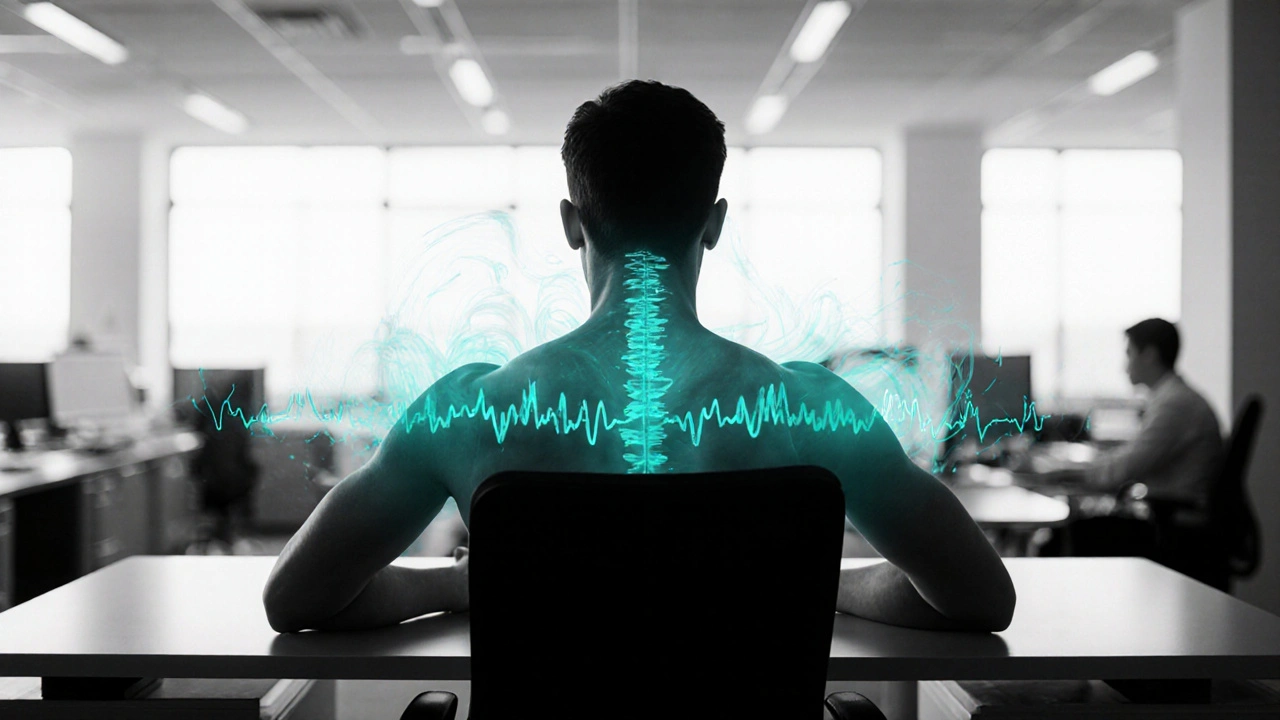Muscle Stiffness Relief Planner
Based on your available time, this tool creates a personalized routine using techniques from the article including breathing exercises, progressive muscle relaxation, and guided body scans.
Your personalized routine will appear here.
Ever felt tightness in your shoulders after a long day at the desk, or a stubborn knot in your neck that just won’t loosen? Those moments are often signs of muscle stiffness, and while stretching or massage can help, the mind‑body connection offers another powerful route. Below you’ll learn practical meditation and mindfulness methods that actually ease tension, improve circulation, and restore flexibility without pricey equipment.
Key Takeaways
- Meditation reduces the stress hormones that keep muscles contracted.
- Mindful breathing and progressive muscle relaxation target specific tight spots.
- Short, daily sessions (5‑10 minutes) are enough to notice softer, more mobile muscles.
- A simple routine can be built around work breaks, bedtime, or after‑exercise cool‑downs.
- Common mistakes - like rushing the practice or ignoring posture - can sabotage results.
What Is Muscle Stiffness?
Muscle stiffness is the feeling of reduced elasticity and limited range of motion caused by micro‑spasms, low blood flow, and lingering stress. When the autonomic nervous system regulates involuntary functions like heart rate and muscle tone, and chronic stress can tip it toward a sympathetic‑dominant state, locking muscles in a semi‑contraction. Over time, this leads to pain, poor posture, and even decreased performance in daily activities.
How Meditation Breaks the Stiffness Cycle
While it sounds surprising, sitting quietly can physically unclench muscles. Meditation is a mental training practice that cultivates focused attention and a calm mind, lowering cortisol and adrenaline levels. Lower stress hormones signal the body to shift from "fight‑or‑flight" to a relaxed state, allowing muscle fibers to lengthen naturally.

Mindfulness: Paying Attention to Sensation
Unlike a generic meditation that may involve a mantra, mindfulness means intentionally observing thoughts, feelings, and physical sensations without judgment. By bringing awareness to the exact spot where tension lives, you give the brain a chance to re‑wire the pain response, reducing the urge to tighten further.
Core Techniques for Stiffness Relief
- Breathing Exercises
Deep diaphragmatic breathing engages the parasympathetic nervous system, which counteracts muscle tightness. Try the 4‑7‑8 method: inhale for 4 seconds, hold for 7, exhale slowly for 8. Do three rounds before a stretch.
- Progressive Muscle Relaxation (PMR)
Progressive muscle relaxation is a step‑by‑step routine where you deliberately tense a muscle group for 5‑7 seconds, then release, noticing the contrast. Starting at the feet and moving upward helps identify hidden knots and frees them one by one.
- Guided Body Scan
This is a mindfulness practice where you mentally “scan” from head to toe, noting any tightness. When you encounter a stiff area, pause, breathe into it, and visualize the muscle softening.
- Yoga‑Based Stretches
Gentle yoga poses, especially those that open the chest, hips, and shoulders, complement meditation by providing a physical lengthening effect. Poses like Cat‑Cow, Child’s Pose, and Thread the Needle are ideal for office workers.

Quick Comparison of Popular Techniques
| Technique | Main Benefit | Time per Session | Best For |
|---|---|---|---|
| Meditation (focus on breath) | Reduces cortisol, promotes overall relaxation | 5‑10min | Stress‑related stiffness |
| Progressive Muscle Relaxation | Targets specific tight spots, improves body awareness | 10‑15min | Chronic knots, nighttime tension |
| Guided Body Scan | Enhances mindfulness, identifies hidden tension | 7‑12min | General stiffness, beginners |
| Yoga‑Based Stretches | Physical lengthening plus calming effect | 10‑20min | Post‑exercise recovery, flexibility goals |
Building a Daily Routine
Consistency beats intensity. Here’s a simple 15‑minute plan you can slot into a work break or before bed:
- Start with 2 minutes of 4‑7‑8 breathing to settle the mind.
- Follow with a 5‑minute guided body scan (use a free app or YouTube track).
- Spend 5 minutes on progressive muscle relaxation, working from feet to shoulders.
- Finish with 3 minutes of gentle yoga - Cat‑Cow and Child’s Pose work well in small spaces.
Notice how your shoulders feel after a week. If the tension eases, slowly extend the yoga portion or add a short walk.

Common Pitfalls and How to Avoid Them
- Rushing the practice - Tension builds when you try to “finish” quickly. Give each breath and muscle contraction the full count.
- Skipping the breath - Breath is the bridge between mind and muscle. Without it, the nervous system stays in sympathetic mode.
- Holding a rigid posture - Sit upright but relaxed; a slouched spine sends mixed signals to the muscles.
- Inconsistent schedule - Aim for at least three sessions a week; sporadic use yields minimal gains.
Quick Checklist for Stiffness Relief
- Find a quiet spot (no more than 5ft from distractions).
- Set a timer for your chosen duration.
- Use a breathable cushion or chair that supports an upright spine.
- Begin with diaphragmatic breathing before any movement.
- Close your eyes or soften your gaze to reduce visual input.
- Stay present - note any arising thoughts, then gently return to the breath.
- End with a gentle stretch to lock in the relaxed state.
Frequently Asked Questions
Can meditation really replace physical therapy for muscle stiffness?
Meditation isn’t a surgical fix, but it works hand‑in‑hand with physical therapy. While therapy addresses structural issues, meditation targets the nervous‑system drivers of tension. Using both together often speeds recovery and reduces the frequency of flare‑ups.
How long before I notice softer muscles?
Most beginners report a subtle release after 5‑7 days of daily 10‑minute sessions. Consistency is key; missed days can reset the nervous‑system response.
Is it safe to do PMR if I have chronic back pain?
Yes, as long as you avoid forcing a painful stretch. Focus on the tension‑release sensation rather than the magnitude of the contraction. If pain spikes, stop the exercise and consult a health professional.
Do I need any special equipment?
No. A comfortable chair, a yoga mat (or carpet), and a quiet environment are enough. A phone or laptop can play guided audio if you prefer.
Can children benefit from these techniques?
Absolutely. Short, playful breathing games and gentle body scans help kids recognize tension early, which can improve posture and focus at school.

Comments (4)
Gail Hooks
October 15, 2025 AT 18:59
I love how you framed meditation as a gentle bridge between mind and muscle 😊.
It reminds me of the ancient philosophy that the body is the temple of the soul.
When we breathe consciously, we’re actually sending a calm signal straight to the nervous system.
That signal tells the sympathetic ‘fight‑or‑flight’ crew to step back and let the parasympathetic team take over.
The result is a softening of those stubborn knots you described.
I’ve tried the 4‑7‑8 method during my lunch break and felt a noticeable release in my shoulders.
Even a quick two‑minute scan can make the difference between a tense afternoon and a relaxed evening.
Keep sharing these nuggets, they’re a real lifeline for desk‑bound warriors.
Derek Dodge
October 30, 2025 AT 20:06
Man i cant believe i just tried the body scan and felt less tight lol
AARON KEYS
November 14, 2025 AT 21:13
The article does a solid job of linking breath work to reduced cortisol levels.
I appreciate the clear step‑by‑step layout, especially the bullet points that summarize each technique.
Progressive muscle relaxation, as described, aligns well with current research on autonomic regulation.
One suggestion would be to mention the role of proper hydration, which can also affect muscle pliability.
Overall, the piece strikes a good balance between practical instruction and scientific background.
Looking forward to trying the 5‑minute routine before my next meeting.
Summer Medina
November 29, 2025 AT 22:19
Honestly this guide feels like a marathon of advice that never stops
You start with breathing and then you jump to scans and then you throw yoga in there like it’s a free buffet
I get that the author wants to cover everything but the reader gets overwhelmed
Each paragraph stacks on the previous one without a breather
The 4‑7‑8 technique is explained well but then you are told to do three rounds before a stretch which feels redundant
The progressive muscle relaxation section could have used a simple table instead of a paragraph wall
And the body scan description goes on and on about visualizing softness in the muscles as if you’re painting a picture
Meanwhile the table in the middle of the article is a nice break but it’s buried under too much text
I also noticed that the author never mentions the importance of a quiet environment beyond the checklist
A quiet space is crucial because external noise can trigger the sympathetic system again
The article briefly mentions a cushion but does not explain why posture is so important
If you slouch even slightly the breathing won’t reach the diaphragm properly
It would have been helpful to include a quick tip about sitting on the edge of a chair
Nevertheless the intention behind the piece is commendable
It tries to unite mind and body in a way that many fitness blogs ignore
I just wish the pacing was less frantic and the headings more spaced out for easy reference